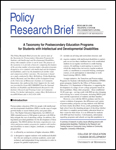Download PDF (934 KB, 8 pp.) To view a PDF file, you'll need Adobe Acrobat Reader on your computer. Acrobat Reader may be downloaded from the Adobe Web site
Text Only Version (below)
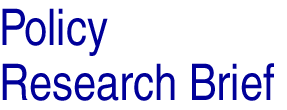
Published by the Research and Training Center on Community Living, Institute on Community Integration • College of Education and Human Development, University of Minnesota
Volume 23 • Number 1 • February 2013
A Taxonomy for Postsecondary Education Programs for Students with Intellectual and Developmental Disabilities
This Policy Research Brief presents the current state of the Taxonomy for Postsecondary Education Programs for Students with Intellectual and Developmental Disabilities, along with examples of how it can be used. The purpose of the taxonomy is to provide a basis for comparing the features of the growing number of postsecondary education programs designed to serve students with intellectual and developmental disabilities, and to lay the foundation for further study and comparison of their outcomes. The taxonomy is based on a study conducted by Mary McEathron, Trisha Beuhring, Amelia Maynard, and Ann Mavis of the Evaluation Group at the University of Minnesota's Institute on Community Integration; they authored this brief. Support for the study was provided by Grant #H133B080005 from the National Institute on Disability and Rehabilitation Research to the Institute’s Research and Training Center on Community Living. For further information, contact Mary McEathron at mceat001@umn.edu or (612) 624-1450.
Introduction
Postsecondary education (PSE) for people with intellectual and developmental disabilities (IDD) is on the cusp of major growth thanks to recent federal policy and grant initiatives. The Higher Education Opportunity Act (HEOA) of 2008 extended access to Pell grants to persons with IDD to help mitigate the cost of attending college. In addition, this legislation provided guidelines for the development of these programs. The HEOA defines the term comprehensive transition and postsecondary program for students with intellectual disabilities to mean a degree, certificate, or nondegree program that:
- is offered by an institution of higher education (IHE);
- is designed to support students with intellectual disabilities who are seeking to continue academic, career and technical, and independent living instruction in order to prepare for gainful employment;
- includes an advising and curriculum structure; and
- requires students with intellectual disabilities to participate on not less than a halftime basis with nondisabled students in (a) regular enrollment in credit-bearing courses, (b) auditing or participating in courses for which the student does not receive regular academic credit, (c) enrollment in noncredit-bearing, nondegree courses, or (d) participation in internships or work-based training (HEOA, 2008).
A major initiative, the Transition and Postsecondary Programs for Students with Intellectual Disabilities (TPSID) grants program, funded by the Office of Postsecondary Education, U.S. Department of Education, is supporting the development of a range of new college programs based on these guidelines. Many older programs – those established 10-20 years ago – serving youth with IDD are also changing and evolving for a variety of reasons, including HEOA guidance and the expectations of students and their families.
However, even with the HEOA guidance and the concurrent evolution of programs, the differences and variety of postsecondary programs serving students with IDD has not been clearly described. Every youth graduating from high school faces the daunting prospect of deciding whether and where to complete postsecondary education based on their vision for their future. It is no different for students with IDD and their families. Unfortunately, information regarding programs and schools serving this population is limited, thus constraining students’ and families’ ability to understand the offerings of individual programs and to make informed choices among programs. This is due both to the rapid increase of these programs and also the lack of a clear set of relevant characteristics to allow for programmatic comparisons.
A preliminary taxonomy for classifying PSE programs for students with IDD was developed in 2010 by the Evaluation Group at the Institute on Community Integration, and was based on a review of published information about past and current programs, an analysis of issues raised by the existing research literature, and a thematic analysis of transcripts of discussions held at the 2009 State Of The Science Conference Postsecondary Education For Students With Intellectual Disabilities (McEathron & Beuhring, 2011). In 2011, the National Institute on Disability and Rehabilitation Research (NIDRR) funded a one-year project at the Evaluation Group for the continued development of the Taxonomy for Postsecondary Education Programs for Students with Intellectual and Developmental Disabilities (PSE Taxonomy). This Policy Research Brief presents the results of that continued development.
Methodology
In order to conduct the field study for the continued development of the PSE Taxonomy, it was first necessary to identify a comprehensive set of PSE programs for which published information was available (which we refer to as the documented population of programs), then to identify an appropriate sampling frame based on the stated goals of this project, and finally, to draw a sample that would be both diverse and representative. Although there are relatively few PSE programs for students with IDD in the U.S., the number is growing. There is also steady turnover, with new programs being created, older programs being discontinued, and still others being revamped as part of improving the program model and obtaining continuation funding. Consequently, any comprehensive listing of these programs is outdated almost as soon as it is constructed. We refer to the documented population of PSE programs as a reminder of these caveats.
To date, three significant attempts have been made by other researchers in the field to identify and describe all known PSE programs in the U.S. for students with IDD. Two were comprehensive reviews of the clinical and research literature. The first, conducted over a decade ago, identified only 13 programs (Neubert, Moon, Grigal, & Redd, 2001). The second identified 47 programs by searching advocacy organization Web sites and the Internet as well as the research literature (Thoma et al., 2011). A third resource was the Think College online database of programs for students with IDD (Think College, 2012). Since only programs that responded to a survey were included in the database, the population of known programs for students with IDD was likely larger than the documented population. Nevertheless, the Think College database identified the largest number of potential programs for students with IDD and provided the information necessary to construct a sampling frame. It was also available in a searchable online format and updated periodically, making it easy to monitor and account for changes in program listings when updating the sampling frame database created during the course of this project.
The documented population of PSE programs was updated three times during this study. In November 2011, at the beginning of the study, the baseline documented population consisted of all 138 programs in the Think College database. In mid-March 2012, it consisted of the 155 programs listed in the Think College database plus a subset of the 27 TPSID programs that we determined had not yet been included in the database. By late May 2012, the documented population of PSE programs had increased to the 165 programs now listed in the Think College database, plus 9 TPSID-funded programs not yet included. A summary of the programs included in the documented population as of May 2012 is provided in Table 1 (see below or view the screen-readable PDF of Table 1).

The documented population of PSE programs was highly diverse, covering a broad range of settings, sponsors, and target populations. Not all were consistent with the primary goal of this project, which was to further develop a classification scheme (taxonomy) that would inform future research and evaluation of programs serving students with IDD at institutions of higher education. The definitions of these two criteria are included here for clarity:
- Definition of Institutions of Higher Education (IHEs). Consistent with the U.S. Department of Education’s definition (NCES, 2008), a two-year community or technical college was defined as a degree-granting institution that awards associate’s degree(s) and/or vocational certificate(s) and participates in Title IV federal financial aid programs. A four-year college or university was defined as a degree-granting institution that awards a bachelor’s degree or higher and participates in Title IV federal financial aid programs.
- Definition of Target Population. In keeping with the intent of this project and the direction of the field, the sampling frame was limited to programs that served students with intellectual disabilities, as defined by advocacy organizations and clinical diagnostic manuals (see AAIDD, 2010; DSM-5, 2010; Merck’s Manual, 2010) or that served both students with intellectual disabilities and students with other developmental disabilities that may include intellectual disabilities as a secondary feature (e.g., autism spectrum disorder).
Therefore, the documented population of 174 PSE programs was narrowed to 98 PSE programs that served students with intellectual disabilities, alone or jointly with developmental disabilities, at institutions of higher education. This subset of the documented population became the sampling frame for the taxonomy development study.
The sampling frame was established to ensure that a diversity of program characteristics would be represented. This was central to accomplishing the project’s goal of creating a foundational taxonomy that would cover the key domains and elements needed to characterize programs that serve students with IDD at institutions of higher education. A secondary aim was to balance the representation of programs by IHE setting and geographical region. A two-stage sampling strategy was implemented with these aims in mind (see Table 2 below or view the screen-readable PDF of Table 2).

In the end, the two-stage sampling strategy produced a sample of 21 programs for which there was in-depth interview data: 9 programs at two-year IHEs and 12 programs at four-year IHEs. The 62% response rate at each stage of sampling produced a comparable response rate for the sample overall. The non-response rate was identical at Stage I and Stage II, even though the samples were approached at different times and might therefore have been affected by seasonal factors or the academic calendar. The response rate for the TPSID programs (Office of Postsecondary Education, 2010) was also identical for Stage I and Stage II. Finally, the response rates for the new TPSID-funded programs and the older non-TPSID programs were similar (67% of 9 contacted vs. 60% of 25 contacted, respectively), suggesting that there was no bias related to historical or policy factors. The level of non-response was low given that program directors were asked to make a 45-minute time commitment for a structured interview. Taken together, these data indicate that the interviewed sample of programs was broadly representative of the sampling frame from which it was drawn. A summary is provided in Table 3 (see below or view the screen-readable PDF of Table 3).

Using the 21 participating sites, the PSE Taxonomy Development Study focused on four main sources of data: interviews with key college and program staff, program materials submitted by sites, information obtained via program Web sites, and an online survey based on the developing taxonomy. The interviews were comprehensive and provided in-depth information about the characteristics of the programs and the students they served. The program materials and online resources provided additional details as well as confirmation of information obtained in the interviews. The survey provided a confirmation of taxonomy elements and the classification of participating sites.
The analysis for this study focused on identifying distinct categories that could be used in the continued development of the PSE Taxonomy and, in combination, to fully characterize the differences and similarities among these programs. We identified three main levels of the taxonomy: Domains, Components, and Elements. Through the analysis of interview transcripts and program materials we first sought to delineate discrete domains. Then, within each domain, we sought to clarify the taxonomic components and elements which provide the foundation or the “genetic code,” so to speak, of a program’s identity. The HEOA prescribes some of the components of eligible programs that serve students with IDD, so it may seem that a taxonomy would simply mirror the legislation. However, we found that there were variations in how programs addressed HEOA. In addition, programs created prior to the legislation also exhibit certain distinct programmatic characteristics that are informative. The following section presents the current taxonomy domains, components, and elements.
Findings
Taxonomy for Postsecondary Education Programs For Students with IDD
The iterative process of analyzing the in-depth interview data, program materials, and survey responses, as well as constructing a logical, well-ordered taxonomy resulted in a structure that has 4 domains, 16 components, and over 100 elements (see McEathron, Beuhring, Maynard, & Mavis, 2012 for the full listing of taxonomic domains, components, and elements). The four major domains are:
- Organizational Domain. Includes the essential program and institutional characteristics that affect the operation of the PSE program.
- Admissions Domain. Focuses on the criteria used to select students (such as academic or functional/behavioral skills) as well as the level of admissions selectivity and cost of attending.
- Support Domain. Encompasses the different types of supports available for students, including financial aid.
- Pedagogical Domain. Includes the elements for academics, vocational, independent living, and social components.
Table 4 (see below or view the screen-readable PDF of Table 4) shows each of those domains with the key components and elements that make up that domain.
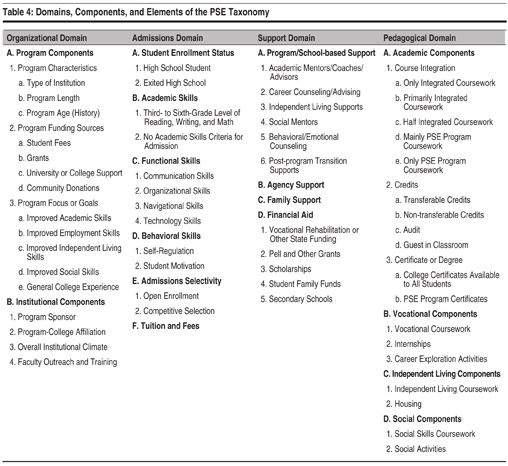
Utility of the PSE Taxonomy
Because the field of PSE for students with IDD is in a highly fluid, evolving state, it is anticipated that over time certain aspects of the domains and elements of the taxonomy may change and that the taxonomic profile of a program may also change. For example, students with IDD in most programs are not currently receiving college-wide certificates or degrees. However, in numerous conversations, program staff reported that they were in the process of developing certificates that any student could pursue. These certificates frequently had a vocational focus (e.g., horticulture, culinary arts, welding). It is reasonable to assume that the elements within the vocational component may expand or change to accommodate this growth in number and type of certificates and degrees offered to students with IDD.
Nonetheless, even in its current iteration, the PSE Taxonomy provides structure for developing comparable program profiles. Table 5 (see below or view the screen-readable PDF of Table 5) presents the profile for a program that participated in the study using a matrix that creates clear, specific profiles based on significant components and elements with the four major PSE Taxonomy domains. Since participating programs were assured that the results of this study would be reported without reference to program names, this program is referred to as “College Program 4D.”
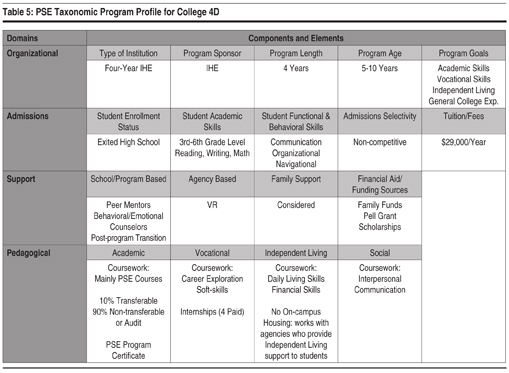
The Taxonomic Profile for College Program 4D shows that this is a four-year program at a four-year college. It requires students to have a third- to sixth-grade level of reading, writing, and math; however, it has an open admissions selection process (almost everyone who applies is accepted and admitted). Students enrolled in this program mainly take PSE program courses (not courses offered to the general college population). The program uses peer mentors and offers behavioral or emotional counseling to students when needed. It also provides post-program transition support. There is no on-campus housing available, but the program works with local agencies that provide housing to students with disabilities; annual tuition is $29,000. A comparable profile can be made for any PSE program for students with IDD.
Discussion
The development of PSE program profiles based on the PSE Taxonomy provides a powerful mechanism for informing a wide audience of stakeholders of the differences and similarities of the available programs. Policymakers, program developers, researchers, and students with IDD and their families need up-to-date information to make decisions. Comprehensive profiles can act as the foundation. They can also be utilized to focus programmatic comparisons on topics most important to the user.
The PSE Taxonomy can also be used for analyzing element combinations to provide a more detailed understanding of PSE programs. For example, the type of credit students receive differs by level of integration and by type of IHE. Table 6 (see below or view the screen-readable PDF of Table 6) presents the credit options reported most frequently by participating study sites by level of course integration and type of institution. Non-transferable credits are the most frequently awarded credit option overall; however, integrated programs in two-year colleges offered transferable credits more frequently and integrated programs in four-year college offered the audit or guest-in-the-classroom option more frequently. Additional focused comparisons can include cost of attending, level of admissions selectivity or competition, focus of program goals, and type of institution.
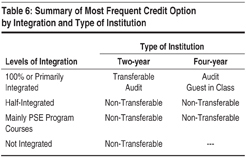
The process of refining the PSE Taxonomy will continue, aided by the engagement of those involved in the process of running, developing, researching, or enrolling in a PSE program for students with IDD. Clarity in the language used to describe elements or the range of options within elements will certainly improve with the continued development of the field. In addition to the proposed uses of the taxonomy listed above, perhaps one of the most exciting possibilities is the use of the taxonomy to study student outcomes: What happens when students complete a program? How are those outcomes associated with taxonomic components or elements, individually or in combination? The PSE Taxonomy is now developed enough to provide a foundation for continued research in this area.
References
American Association on Intellectual and Developmental Disabilities [AAIDD]. (2010). Intellectual disability: Definition, classification, and systems of supports (11th Ed.). Retrieved from http://www.aamr.org/intellectualdisabilitybook/
Diagnostic and statistical manual for mental disorders [DSM-5]. (2010). Retrieved from www.dsm5.org
Higher Education Opportunity Act. (2008). Pub. L. No. 110-315. 122 STAT. 3078 (2008).
McEathron, M., & Beuhring, T. (2011). Postsecondary education for students with intellectual and developmental disabilities: A critical review of the state of knowledge and a taxonomy to guide future research. Policy Research Brief, 21(1). Minneapolis, MN: University of Minnesota, Institute on Community Integration. Retrieved from http://ici.umn.edu/products/prb/211/default.html
McEathron, M., Beuhring, T, Maynard, A., & Mavis, A. (2012). A taxonomy for postsecondary education programs for students with intellectual and developmental disabilities: Development study. (Technical Report). Minneapolis, MN: University of Minnesota, Institute on Community Integration.
Merck’s Manual. (2010). Mental Retardation/Intellectual Disability. Retrieved from http://www.merckmanuals.com/professional/pediatrics/learning_and_developmental_
disorders/intellectual_disability_id.html#v1105019
National Center for Education Statistics [NCES]. (2008). Digest of education statistics. Washington, DC: U.S. Department of Education, Author. Table 266: Degree-granting institutions and branches, by type and control of institution and state or jurisdiction, 2008-09. Retrieved from http://nces.ed.gov/programs/digest/d09/tables/dt09_266.asp
Neubert, D. A., Moon, M. S., Grigal, M., & Redd, V. (2001). Postsecondary educational practices for individuals with mental retardation and other significant disabilities: A review of the literature. Journal of Vocational Rehabilitation, 16, 155–168.
Office of Postsecondary Education [OPE]. (2010). Transition and Postsecondary Programs for Students with Intellectual Disabilities (TPSID). Washington, DC: U.S. Department of Education. Retrieved from http://www2.ed.gov/programs/tpsid/index.html
Think College. (2012). Think College program database. Retrieved from http://www.thinkcollege.net/?Itemid=127
Thoma, C. A., Lakin, K. C., Carlson, D., Domzal, C., Austin, K., & Boyd, K. (2011). Postsecondary education for students with intellectual disabilities: A review of the literature 2001-2010. Unpublished paper submitted for publication.
Related Institute Publications
The following other resources published by the Institute on Community Integration may be of interest to readers of this Policy Research Brief.
- Policy Research Brief: Postsecondary Education for Students with Intellectual and Developmental Disabilities: A Critical Review of the State of Knowledge and a Taxonomy to Guide Future Research (2011). This issue of Policy Research Brief reviews the state of knowledge and research practice in the emerging field of postsecondary education for students with intellectual and other learning-related developmental disabilities. The authors additionally propose a taxonomy to better organize and structure research and program descriptions in support of an improved knowledge base. Cost: Free online at http://ici.umn.edu/products/prb/211/default.html. Print copies are also available for $3 from the Publications Office at (612) 624-4512 or icipub@umn.edu
- Impact: Feature Issue on Postsecondary Education and Students with Intellectual, Developmental and Other Disabilities (2011). Even though the majority of high school students with disabilities identify participation in postsecondary education as a goal for their adult lives, only about 3 in 10 have taken classes since completing high school (National Longitudinal Transition Study-2). And among those with the lowest rates of participation are students with intellectual disabilities. This Impact issue explores what we know, and what we still need to know, about supporting increased participation of students with disabilities – especially those with intellectual disabilities – in postsecondary education, and why that participation is important. It includes articles from families, young adults with disabilities, and professionals. Cost: Free online at http://ici.umn.edu/products/impact/233. Print copies are also available (first copy free, each additional $4) from the Publications Office at (612) 624-4512 or icipub@umn.edu.
- Quality Mall (www.qualitymall.org). Operated by the Research and Training Center on Community Living, this online clearinghouse of quality materials from around the country includes over 200 resources on noteworthy practices in the many different areas of employment and jobs. Resources in the Employment area are grouped into the following categories:
— Employment Policy, Strategy and Funding
— Employment Tools for Self-Advocates
— Information for Employers
— Self-Employment and Business Ownership
— Staff Development for Employment
— Wage Employment
— Work Incentives
— Transportation
This publication is supported, in part, by Cooperative Agreement #H133B080005 from the National Institute on Disability and Rehabilitation Research (NIDRR), U.S. Department of Education.
The opinions expressed are those of the authors and do not necessarily reflect the position of the Center or its funding sources.
Print copies of this publication are available for $3.00 per copy. An order form is available online, or contact:
Publications Office
Institute on Community Integration
University of Minnesota
109 Pattee Hall
150 Pillsbury Drive SE
Minneapolis, MN 55455
612/624-4512
icipub@umn.edu
Policy Research Brief is available in alternative formats upon request from the above address.

The University of Minnesota is an equal opportunity employer and educator.
Published on the Web site of the Institute on Community Integration, University of Minnesota (http://ici.umn.edu)
